-
Insulate, insulate, insulate – savings of up to £730 per year
Retrofitting insulation in older homes can range between £1,400 and £12,500, depending on property size, type, and existing insulation. For instance, insulating solid walls in older buildings is more complex than upgrading modern homes with cavity walls. Poor insulation allows 25% of a home’s heat to escape through the roof, and 35% to 40% through walls.
Insulation addresses these weak spots, reducing heating needs and saving £630 to £730 annually on energy bills. Financial relief is available through initiatives like zero-rated VAT on home insulation, valid until March 2027.
On a budget? Start with low-cost, high-impact upgrades like loft insulation (from £300) or draught-proofing with weatherstripping or caulk. Adding thick curtains, blinds, or carpets and rugs can also reduce heat loss. Available until March 2025, the Home Upgrade Grant (HUG) can cover up to 60% of insulation costs for eligible households.
-
Solar panels – savings of up to £660 per year
Installing a full solar panel system typically costs between £4,000 and £8,000 for an average-sized home, but can reduce electricity bills by up to 70%. This potentially saves you around £660 a year, while boosting your home’s value by up to 14%. Homeowners typically break even in about 15.5 years, with savings continuing for the next 10-15 years of their 25 to 30-year lifespan. Homes with south-facing roofs benefit from optimal sunlight exposure, speeding up ROI.
On a budget? If a full installation is too costly, consider starting with a smaller, solar-powered system for things like water heating, which can cost as little as £2,000. Another option is to invest in solar-powered outdoor lighting or appliances, which can reduce energy consumption without the large initial expense.
-
Heating system upgrade – savings of up to £290 per year
Replacing an outdated boiler with an air source heat pump can cost between £8,750 and £14,050 on average, offering year-round benefits such as cooling and dehumidifying.
These systems generate 3 to 4 times more energy than they consume, potentially saving homeowners up to £290 annually on energy bills, with a 14-year break-even period. Additionally, the Boiler Upgrade Scheme can provide up to £7,500 off installation costs for those in England and Wales.
On a budget? Opt for budget-friendly upgrades like a smart thermostat which costs between £120 and £220, to minimise energy waste. Another low-cost option is radiator reflector panels (£30–£100), which improve heat distribution throughout your home. These panels are most effective when placed on exterior walls, where heat loss is most significant, helping to reduce heat loss by up to 45%.
-
Energy-efficient appliances – consume up to 90% less energy
Swapping out old, inefficient appliances for energy-efficient models is a practical way to lower energy costs. While replacement costs range from £500 to £2,000 depending on the item, the most energy-intensive devices like washing machines, refrigerators, and dishwashers are key targets for upgrades.
For instance, modern washing machines are far more efficient than their 1990s counterparts, which consumed around 400 kWh annually for three weekly washes – that’s around 84% more than today’s models (65 kWh).
On a budget? Start with cost-effective upgrades like LED bulbs, which use up to 90% less energy and last 25 times longer than incandescent bulbs, saving £30-£50 per year. If replacing all appliances isn’t possible, focus on the highest energy consumers, and opt for A-rated models for better efficiency and long-term savings.
-
Water efficiency measures – cut up to 50% off water bills
Water usage also plays a crucial role in your home’s overall energy efficiency, and the UK’s rainy climate offers a chance to save money and reduce your environmental footprint. Installing a rainwater harvesting system, which costs around £2000 to £3,000 on average, allows households to cut up to 50% off water bills by repurposing rainwater for washing machines, toilet flushing, and garden irrigation.
On a budget? For a budget-friendly start, fit water-efficient showerheads (£10 to £30), dual-flush toilets (around £150 to £600), and add aerators to your taps. These simple upgrades can significantly reduce water usage, leading to noticeable savings. A dual-flush toilet, for example, uses just 4 to 6 litres per flush, compared to 13 litres for a traditional model.
Heath Alexander-Bew, Director at green landlord insurance experts Alan Boswell Group, shared key insights on how eco-friendly upgrades can affect insurance premiums.
He said, “Insurers are increasingly interested in the steps property owners take to make buildings more eco-conscious. Some alterations may lower perceived risks, others could increase them, and certain changes might come with specific conditions.
“For commercial property insurance, such as landlords’ insurance, we strongly recommend informing your insurer or broker about any significant alterations – whether eco-conscious or not. For regular household insurance, the responsibility to disclose changes is less strict, as insurers or brokers are expected to inquire about alterations. However, if you’re unsure, it’s always best to mention them. Doing so helps prevent complications when you make a claim.”






Leave a Comment